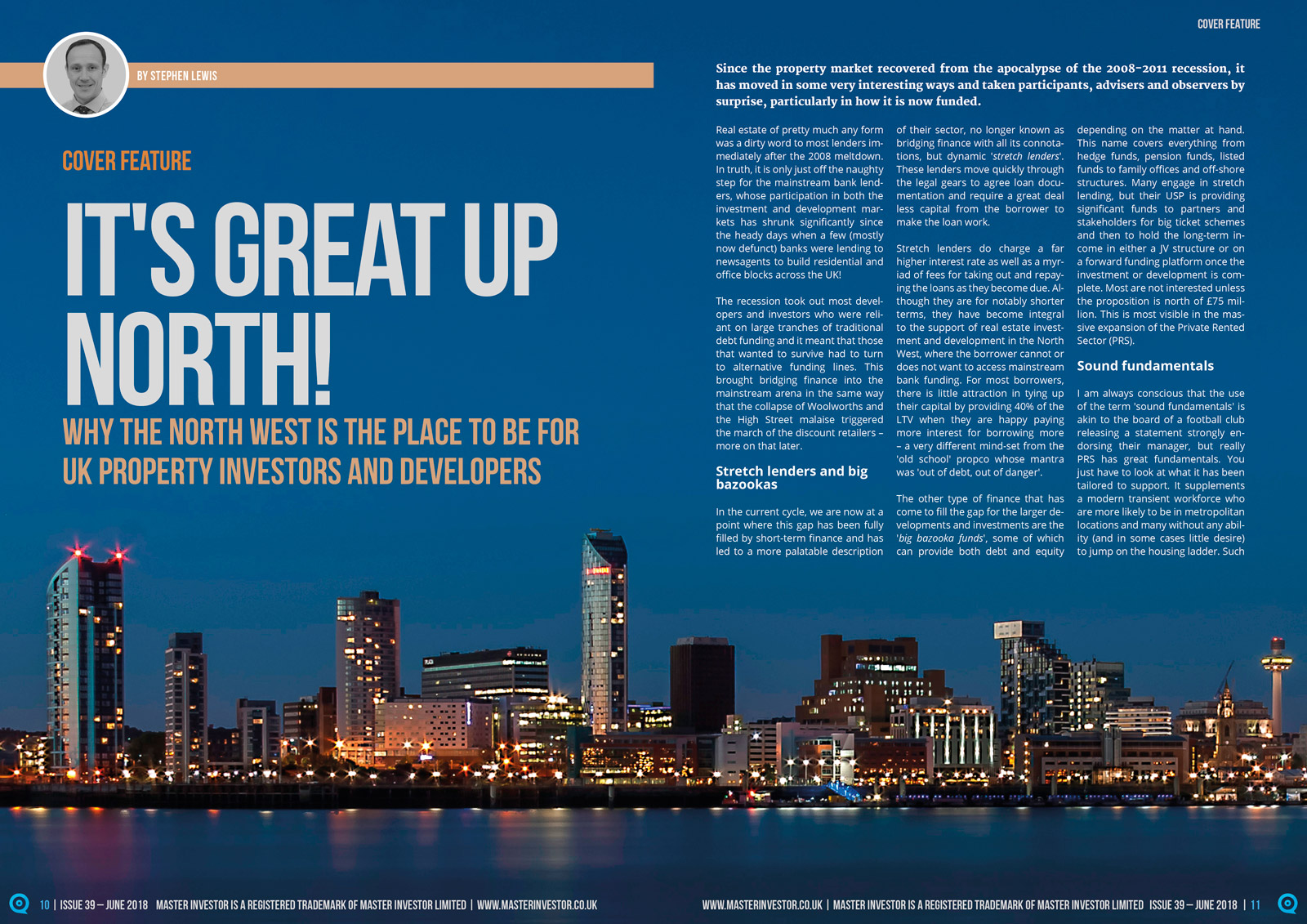Why the North West is the place to be for UK property investors – MAGAZINE EXCLUSIVEMAGAZINE EXCLUSIVE

MAGAZINE ARTICLE
This article first appeared in Issue 39 of Master Investor Magazine.
Click here to download the article as a printer-friendly PDF
|
Get this article and many more – for free! |
Since the property market recovered from the apocalypse of the 2008-2011 recession, it has moved in some very interesting ways and taken participants, advisers and observers by surprise, particularly in how it is now funded.
Real estate of pretty much any form was a dirty word to most lenders immediately after the 2008 meltdown. In truth, it is only just off the naughty step for the mainstream bank lenders, whose participation in both the investment and development markets has shrunk significantly since the heady days when a few (mostly now defunct) banks were lending to newsagents to build residential and office blocks across the UK!
The recession took out most developers and investors who were reliant on large tranches of traditional debt funding and it meant that those that wanted to survive had to turn to alternative funding lines. This brought bridging finance into the mainstream arena in the same way that the collapse of Woolworths and the High Street malaise triggered the march of the discount retailers – more on that later.
Stretch lenders and big bazookas
In the current cycle, we are now at a point where this gap has been fully filled by short-term finance and has led to a more palatable description of their sector, no longer known as bridging finance with all its connotations, but dynamic ‘stretch lenders’. These lenders move quickly through the legal gears to agree loan documentation and require a great deal less capital from the borrower to make the loan work.
Stretch lenders do charge a far higher interest rate as well as a myriad of fees for taking out and repaying the loans as they become due. Although they are for notably shorter terms, they have become integral to the support of real estate investment and development in the North West, where the borrower cannot or does not want to access mainstream bank funding. For most borrowers, there is little attraction in tying up their capital by providing 40% of the LTV when they are happy paying more interest for borrowing more – a very different mind-set from the ‘old school’ propco whose mantra was ‘out of debt, out of danger’.
The other type of finance that has come to fill the gap for the larger developments and investments are the ‘big bazooka funds’, some of which can provide both debt and equity depending on the matter at hand. This name covers everything from hedge funds, pension funds, listed funds to family offices and off-shore structures. Many engage in stretch lending, but their USP is providing significant funds to partners and stakeholders for big ticket schemes and then to hold the long-term income in either a JV structure or on a forward funding platform once the investment or development is complete. Most are not interested unless the proposition is north of £75 million. This is most visible in the massive expansion of the Private Rented Sector (PRS).
Sound fundamentals
I am always conscious that the use of the term ‘sound fundamentals’ is akin to the board of a football club releasing a statement strongly endorsing their manager, but really PRS has great fundamentals. You just have to look at what it has been tailored to support. It supplements a modern transient workforce who are more likely to be in metropolitan locations and many without any ability (and in some cases little desire) to jump on the housing ladder. Such vertical conurbations, when developed out in bulk, create a fairly predictable income stream at inflation-linked pricing. The main area of concern is ensuring your capex is covered by your sinking fund, given most require a refurb every 7-8 years.
In Manchester alone, the PRS pipeline runs into the thousands and is underpinned by significant growth of the city as a business hub. Manchester’s business reputation is complemented by an already world-class university and science base, with the two main football clubs adding that sprinkle of stardust which plays very well overseas and cannot be underestimated. Two Manchester-based companies delivering significant schemes in the North West are Glenbrook (www.glenbrookproperty.co.uk) and Select Property Group (www.selectproperty.com), both of whom are well established and continue to attract attention from the ‘bazooka funds’ who wish to allocate resources into these long-term income-generating assets.
In conjunction with the delivery and expansion of the PRS model, the residential sector (both apartments and more standard housing) has proved very resilient.The tap is still fully on when funding individuals in their desire to get on the housing ladder, and for the more central apartment schemes, there is still strong appetite from abroad to have a piece of the action in the main two cities of Liverpool and Manchester. One nice problem the developers have at the moment is holding back apartments for UK purchasers, such is the current demand as a result of the weak pound and the attractive yields of 6-8%, without any need for management input given this is already parcelled up in the sales package.
Most developers of residential apartments in these two main cities access both the stretch lenders and the big bazooka funds. Done well, it is an efficient way of building out apartment blocks, with deposits released and held as security for the funding or, alternatively, used in the build itself. This de-risks the scheme for both developer and funder, and helps with cashflow throughout the project. On the commercial side, Allied London (www.alliedlondon.com) has transformed a once unloved area north of Deansgate into a cluster of grade A office blocks supported by an upmarket leisure scene. The latest arrival on the scene is the Ivy, which services the growing disposable income generated by the Manchester workforce and aspirational visitors.
Haves and have nots
Retail, like the US version of capitalism, is clearly split these days into the ‘haves’ and the ‘have nots’. Putting the internet to one side for a minute, the bricks-and-mortar operations are finding that a high street Zone A presence is close to becoming unsustainable, particularly for those whose products can easily be bought at the click of an Amazon ‘proceed to checkout’ button. What is saving some locations, and, in fact, driving footfall and underwriting strong rents, is a leisure component to sustain a person’s interest in being there and ensure other members of the family can disappear whilst you enjoy a drink, a bite to eat, or even a bit of crazy golf.
The Grosvenor development in Liverpool, known as L1, does this extremely well, and has survived through developing and expanding its offering to attract, what is now, a thriving tourist industry for the city. This footfall continues to be driven by the lure of staycations in the UK, alongside international interest from visitors craving culture around the three graces and wanting their picture taken down Mathew Street, by the Liver Building or at Anfield or Goodison.
The ‘have nots’ will soon disappear from the High Street mix and the Government needs to bring some relief to beleaguered landlords and tenants by reducing the burden of rates (which, like National Insurance, is really just another tax), or otherwise introducing an internet tax to level the playing field. As for the ‘haves’, they continue to make hay, most of them being either discount retailers who are able to negotiate fixed rents in previously unattainable positions on the High Street, or those retailers offering something different, unique, or an experience that cannot be replicated at the click of a button.
Northern powerhouse
Generally, the real-estate footprint in the North West is thriving, as it has re-positioned itself along value-based grounds. No longer do Liverpool and Manchester view each other with suspicion and disdain (save on the football terraces); in fact, they work in conjunction to promote each other, as was seen at MIPIM recently, and will be visible at the International Business Festival (www.internationalbusinessfestival.com) in Liverpool this June.
In the commercial sector, the repositioning of the retail offering is making for more vibrant high street experiences in many locations, with the retail parks like the Trafford Centre more than holding their own on Zone A rents, backed up by strong footfall. Where there are winners there are always losers, and secondary and tertiary locations will continue to suffer until there is a more holistic review of how best to reposition the old Victorian shopfronts and retail parades, so they can complement the online offering that will be the dominant force of the future.
In the residential sector, a buoyant economy and a population which is less inclined to head down south on graduation has led to a strong pipeline of schemes across the North West to service owner-occupiers, the PRS market and the overseas ‘buy to let’ market. Prices are currently on an upward curve, and in the most recent market surveys, the North West has been shown to be an area that will outperform its peers. Apologies for bringing George Osborne into this, but the North West has been, and continues to be, the ‘powerhouse’ behind the Northern Powerhouse and should cement that position in the coming years.
About Stephen
Stephen Lewis qualified as a solicitor in 2002, became a Partner in 2008, and works in the Manchester office of national practice Freeths, albeit he spends a day or so every couple of weeks in their Mayfair office. Stephen specialises in real estate development and investment throughout the UK but predominantly in the North of England. He acts for two significant European family offices managing their £300 million plus UK real estate assets and in the last few years for funds and developers in the dynamic PRS and residential market of central Manchester and Liverpool which continues to go from strength to strength.


Comments (0)